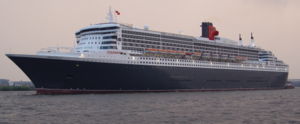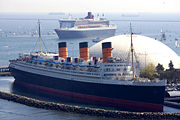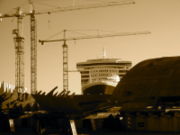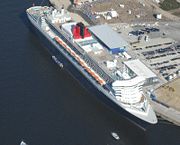RMS Queen Mary 2
2008/9 Schools Wikipedia Selection. Related subjects: Air & Sea transport
 QM2 port bow |
|
| Career | |
|---|---|
| Name: | RMS Queen Mary 2 |
| Owner: | Carnival Corporation & plc |
| Operator: | Cunard Line |
| Port of Registry: | Southampton, |
| Ordered: | 6 November 2000 |
| Builder: | Chantiers de l'Atlantique |
| Cost: | UK £460 million (€700 million) (US $900 million) |
| Laid down: | 4 July 2002 |
| Launched: | 21 March 2003 |
| Christened: | 8 January 2004 by Queen Elizabeth II |
| Maiden voyage: | 12 January 2004 |
| Status: | in service |
| Notes: | IMO number 9241061 |
| General characteristics | |
| Tonnage: | 148,528 gross tons |
| Displacement: | 76,000 tonnes (approx) |
| Length: | 345 m (1,132 ft) |
| Beam: | 41 m (135 ft) waterline, 45 m (147.5 ft) extreme (bridge wings) |
| Height: | 72 m (236.2 ft) keel to funnel |
| Draft: | 10 m (32 ft 10 in) |
| Decks: | 13 passenger decks |
| Installed power: | 117 MW (157,000 horsepower) CODAG |
| Propulsion: | four 21.5 MW electric propulsor pods: 2 fixed and 2 azimuthing |
| Speed: | approx. 30 knots (56 km/h/35 mph) |
| Capacity: | 2,620 passengers |
| Crew: | 1,253 officers and crew |
The RMS Queen Mary 2 (QM2) is a Cunard Line ocean liner named after the earlier Cunard liner Queen Mary, which was in turn named after Mary of Teck, the Queen Consort of George V. At the time of her construction in 2003 by the Chantiers de l'Atlantique, the QM2 was the longest, widest and tallest passenger ship ever built, and at 148,528 gross tons, was also the largest. She lost that last distinction to Royal Caribbean International's 154,407 gross ton Freedom of the Seas in April 2006, but QM2 remains the largest ocean liner (as opposed to cruise ship) ever built, and her width, length, and waterline breadth are unsurpassed by any other passenger ship. Also, the QM2 displaces approximately 76,000 tons; the Royal Caribbean Freedom ships displace about 64,000 tons.
QM2's facilities include 15 restaurants and bars, five swimming pools, a casino, a ballroom, a theatre, and a planetarium.
Characteristics
The Queen Mary 2 is the current Cunard flagship and makes regular transatlantic crossings. The ship was constructed to complement the RMS Queen Elizabeth 2 (QE2) - the Cunard flagship from 1969 to 2004 - replacing it on the transatlantic route. The first RMS Queen Mary sailed the Atlantic from 1936 to 1967. QM2 had the Royal Mail Ship (RMS) title conferred on her, as a gesture to Cunard's history, by Royal Mail when she entered service in 2004 on the Southampton to New York route.
The QM2 is not a steamship like her predecessors, but is powered by gas turbines and diesel engines that produce the power to drive her four electric podded propulsors. Like her predecessors, however, she is built for crossing the Atlantic ocean, though she is used for cruising purposes from time to time; QM2's 30 knot open ocean speed sets the ship apart from cruise ships, such as Freedom of the Seas, which has an average speed of 21.6 knots.
History
Concept and construction
The vision of a 21st century ocean liner — bigger than any that had gone before — started as the brainchild of Carnival CEO Micky Arison, who has stated that his company bought Cunard to create Queen Mary 2, not vice versa.
Cunard completed a design for a new class of 84,000-ton, 2,000-passenger liners on 8 June 1998, but immediately revised them upon comparing those specifications with Carnival Cruise Lines' 100,000-ton Destiny-class cruise ships and Royal Caribbean's 137,200-ton Voyager of the Seas.
Six months later, on 10 December Cunard released details of "Project Queen Mary", the project to develop a liner that would complement Queen Elizabeth 2. Harland and Wolff of Northern Ireland, Aker Kværner of Norway, Fincantieri of Italy, Meyer Werft of Germany, and Chantiers de l'Atlantique of France were invited to bid on the project. If construction began immediately, the liner could be in service by 2002. But it was not until 6 November 2000 that a contract was signed with Chantiers de l'Atlantique, a subsidiary of Alstom. This was the same yard that built Cunard's one-time rivals, the SS Normandie and SS France of the Compagnie Générale Transatlantique.
Her keel was laid down on 4 July 2002, in Saint-Nazaire, France. Approximately 3,000 craftsmen spent some 8 million working hours on the ship, and a total of 20,000 people were directly or indirectly involved in her design, construction, and fitting out. In total, 300,000 pieces of steel were assembled into 94 "blocks" off of the drydock, which were then stacked and welded together to complete the hull and superstructure. She is so much larger than the ships that Chantiers normally build that the shipyard treated her as "1.6 ships."
The QM2 was floated on 21 March 2003. Her sea trials were conducted between 25 September- 29 September and 7 November- 11 November 2003, between Saint-Nazaire and the off-shore islands of Ile d'Yeu and Belle-Ile. The final stages of construction were marred by a fatal accident on 15 November 2003, when a gangway collapsed under a group of shipyard workers and their relatives who had been invited to visit the vessel. 48 people on the gangway fell over 15 m (50 ft); 32 were injured and 16, including a child, were killed.
Construction was completed on schedule. Due to the size of the ship, the luxury of materials, and the fact that, due to her nature as an ocean liner, she required 40% more steel than a standard cruise ship, the final cost ended up being approximately $300,000 US per berth - nearly double that of ships such as Voyager of the Seas, Grand Princess, or Carnival Conquest.
Cunard took delivery in Southampton, England on 26 December 2003. On 8 January 2004, the liner was named Queen Mary 2 by her namesake's granddaughter, Queen Elizabeth II.
Service history
On 12 January 2004, the Queen Mary 2 set sail on her maiden voyage from Southampton, England to Fort Lauderdale, Florida in the United States, carrying 2,620 passengers under tight security due to terrorist threats.
During the XXVIII Olympics the QM2 sailed to Athens and docked at Piraeus for two weeks for use as a hotel-ship, serving the then Prime Minister of the UK Tony Blair and his wife Cherie, the French President Jacques Chirac, former US president George H. W. Bush, and the US Olympic men's basketball team.
One 2005 transatlantic crossing saw the QM2 carrying, in a locked steamer trunk, the first US copy of J. K. Rowling's book Harry Potter and the Half-Blood Prince, autographed by the author. In a promotional press release for the event, Cunard said (though without cited verification) that this marked the first time a book had been transported to its international launch aboard an ocean liner.
The QM2 in January 2006, embarked on a circumnavigation of South America. Upon departure from Fort Lauderdale one of her propeller pods was damaged when it struck a channel wall, forcing the ship to sail at a slower speed, which resulted in Commodore Warwick's decision to skip several calls on its voyage to Rio de Janeiro. Many of her passengers threatened to stage a sit-in protest because of the missed calls, before Cunard offered to refund the voyage costs. The QM2 continued to run on reduced speed, and several itinerary changes were necessary until repairs had been completed after the ship returned to Europe in June, where the QM2 paid a visit to dry dock, and the damaged propeller pod was unseated. In November the QM2 was dry-docked once more at the Blohm + Voss yard in Hamburg (drydock Elbe 17) for the reinstallation of the repaired propeller pod. At the same time, sprinkler systems were installed in all of the vessel's balconies to comply with new safety regulations which had come into effect since the MV Star Princess fire. Additionally, both bridge wings were extended by 2 metres to improve visibility.

After completing the journey around South America, on 23 February 2006, the QM2 met her namesake, the original RMS Queen Mary, which is permanently docked at Long Beach, California. Escorted by a flotilla of smaller ships, the two Queens exchanged a "whistle salute" which was heard throughout the city of Long Beach.
On 10 January 2007 the QM2 started her first world cruise, circling the globe in 81 days. On 20 February, she met her fleet-mate, the Queen Elizabeth 2, also on her 2007 world cruise, in Sydney harbour. This is the first time two Cunard Queens have been together in Sydney since the original Queen Mary and Queen Elizabeth served as troop ships in 1941. Despite the early arrival time of 5:42 am, the QM2's presence attracted so many viewers that the Sydney Harbour Bridge and Anzac Bridge were blocked. With 1,600 passengers leaving the ships in Sydney, Cunard estimated the stopovers injected more than $1 million into the local economy.
On 3 August 2007 three men were arrested while piloting and escorting a replica of a Turtle within 200 feet of the QM2 without authorization at New York City's cruise ship terminal.
The QM2 met the Queen Victoria and the Queen Elizabeth 2 near the Statue of Liberty in New York City harbour on January 13, 2008, with a celebratory fireworks display; the QE2 and QV made a tandem crossing of the Atlantic for the meet. This marked the first time three Cunard Queens have been present in the same location. Cunard purported this to be the last time these three ships will ever meet, due to the QE2's impending retirement from service in late 2008.
Famous passengers and/or guests of the QM2 include Queen Elizabeth II, Prince Philip, Duke of Edinburgh, former French President Jacques Chirac, former British Prime Minister Tony Blair, jazz musician Dave Brubeck, former US president George H. W. Bush, comedian and actor John Cleese, actor Richard Dreyfuss, author and editor Harold Evans, director George Lucas, singer Carly Simon, singer Rod Stewart, CBS Evening News anchor Katie Couric, and financier Donald Trump.
Design
Exterior

The Queen Mary 2's principal architect was Carnival's house designer, Stephen Payne, a self-admitted ocean liner aficionado. While the primary reference point for the vessel's design was undoubtedly that of her running mate Queen Elizabeth 2, her exterior lines also show hints of other vessels. She resembles her predecessor Queen Mary in the curved forward bridge screen, the tower-like ends of which rise to the bridge wings. The forward whaleback is reminiscent of many CGT liners, particularly the Normandie and the France. The two slender after-stacks are a further direct reference to the France.
The QM2 has 14,164 m² (3.5 acres) of exterior deck space, with similar wind screens to shield passengers from gusts as the ship travels at high speeds. Four of the ship's five swimming pools are outdoors; one of these is only one inch deep for the use of small children. The fifth pool is indoors on Deck 12, though covered with a retractable magrodome.
In common with liners such as SS Rotterdam there is a continuous wrap-around promenade deck on Deck 7. The promenade passes behind the bridge screen and allows passengers to completely circumnavigate the deck while protected from the strong winds generated by the ship at full speed. One circuit of the promenade is a distance of 620 metres (2034 ft., or 1/3 mile). The flanking promenades are created by the need to step the superstructure in, to allow for space for lifeboats. By SOLAS standards the lifeboats should have been lower on the ship's hull (15 m above waterline), but for the sake of the QM2's appearance as well as to avoid the danger of large North Atlantic waves damaging the boats in a storm, Payne convinced SOLAS officials to exempt the QM2 from this requirement, and the boats are 25 m above the waterline.
One aspect of the QM2 that has been criticised is the counter of her stern. Payne's intent was to make the ship's stern profile similar to that of the QE2, with a spoon shape, but the mounting of the propeller pods required a flat transom. The compromise was a Constanzi stern – a combination of a more traditional cruiser stern with a contemporary box-like transom stern. The design of the stern has ironically been criticized from two diametrically opposed perspectives by liner buffs. Some feel that nothing but a traditional cruiser stern would be suitable for a true ocean liner, whereas others feel that his choice of stern represents a purely visual conceit that detracts from the quintessentially functional nature of a liner. In fact, Payne has specifically said that he would not resort to adding any non-functional elements to the QM2's design purely to make her appear more "liner-like". It can indeed be argued that the stern satisfies a mixture of functional and aesthetic requirements: A Constanzi stern provides the transom required for azimuthal pod propulsors, yet provides better seaholding characteristics in a following swell than a standard transom stern. The stern design, too, has been seen by some as a homage to earlier (especially Italian-built) liners such as the SS Eugenio C. and the SS Oceanic.
The vessel as completed does exhibit one other subtle element of visual fakery: the three thick black lines that wrap around either edge of her bridge screen. The purpose of these seem to be to recall the appearance of the crossovers of the forward decks on the original Queen Mary or on the Titanic.
In common with many modern ships, both passenger and cargo, QM2 has a bulbous bow to reduce drag and thereby increase speed, range, and fuel efficiency.
The somewhat squat appearance of the smokestack reflects a fairly late alteration to the vessel's design. Originally the funnel's proportions would approximately have matched those of the stack fitted to the Queen Elizabeth 2 after that vessel's re-engining. However, the original design would not allow the QM2 to fit under the Verrazano-Narrows Bridge in New York City. (Even as eventually built, the QM2's shortened smokestack has barely 3 m (9.75 ft) clearance under that bridge.) This makes the QM2 the second major British liner to have her design adapted in order to fit under a bridge at her primary foreign port of call: the top section of the radar mast on the SS Canberra could cantilever astern in order to fit under the Sydney Harbour Bridge.
As the QM2 is too large to dock in most ports, passengers are ferried to and from the ship in specially-built tenders. While at sea, these are stored in davits alongside the lifeboats. To transport passengers to shore, the tenders will pull up to one of four loading stations, named Kensington, Chelsea, Knightsbridge and Belgravia, which each have a large hull door that hydraulically opens outwards to form a boarding platform, complete with railings and decking.
Interior
Contrary to the traditional practice on ocean liners, the main public rooms of the Queen Mary 2 are on the lowest public decks of the ship, with the passenger cabins stacked above. This allowed for larger rooms to be contained within the stronger hull, as well as for more passenger cabins to have private balconies - an essential requirement for ocean passengers in the late 20th and early 21st centuries. Payne attempted to create a central axis to the two main public room decks (similar in fashion to the Normandie), but a full vista is broken by various public rooms that span the width of the ship. The dining rooms were placed further aft, though not directly at the stern, as done on some cruise ships like Royal Caribbean's Voyager of the Seas, where vibration from the propellers at full speed would cause discomfort to dining passengers, as well as where fore-aft pitching of the ship is most noticeable.
Deck 2, the lowest passenger deck, contains the Illuminations theatre, cinema and planetarium; Royal Court Theatre; Grand Lobby; Empire Casino; Golden Lion Pub; and the lower level of the Britannia Restaurant. Deck 3 holds the upper levels of Illuminations, the Royal Court theatre and the Britannia Restaurant, as well as a small shopping arcade, Veuve Cliquot champagne bar, the Chart Room, Sir Samuel's wine bar, the Queen's Room, and the G32 Nightclub. The other main public deck is Deck 7, on which are the Canyon Ranch Spa, Winter Garden, King's Court, the Queen's Grill Lounge, and the Queen's Grill and Princess Grill restaurants for higher-fare passengers. The public rooms on Deck 8 include the à la carte Todd English Restaurant, the largest library at sea (the record was previously held by QE2), a book shop and the upper part of the Canyon Ranch Spa. Also on Deck 8 is a large outdoor pool and terrace at the stern.
The King's Court area on the ship is open 24 hours a day, serving as a buffet restaurant for breakfast and lunch. The overall space is divided into quarters, with each section decorated according to the theme of the four separate alternate dining venues that are "created" each evening through lighting, tableware, and menues: Lotus, which specialises in Asian cuisine; the Carvery, a British-style grille; La Piazza, with Italian food; and the Chef's Galley, which offers an interactive experience to food preparation. From midnight onwards the La Piazza section remains open as a buffet until 6:00 AM, when the full space opens again to serve breakfast.
It has been argued that the separation of passengers into different restaurants based on the price of the cabin they booked (the Britannia as "standard" for regular cabins, the Princess Grill as "middle" for those in junior suites, and the Queen's Grill as "superior" for deluxe suite occupants) makes the QM2 a ship divided into three classes, despite the fact that all other public rooms are used by all passengers equally. Though this situation is similar on the QE2, it is further enhanced on the QM2 by the fact that "Grill Passengers" (those dining in the Princess Grill or Queen's Grill) also have a private outdoor deck with its own whirlpool on Deck 11.
As the QM2 was the first single-class ocean liner built since the immigrant ships of the early part of the 20th century (unlike her fleet-mate the Queen Elizabeth 2, which was originally built for three classes, and in her early years operated partly as a single-class cruise ship and partly as a "classed" liner), the QM2 could afford to have a clearer arrangement of staircases and passages that does not have to allow for doors and partitions being closed off when the ship is in a "classed" transatlantic mode.
However, due to the arrangement of the public rooms, there are some "kinks" in the design. For instance, as the Britannia Restaurant takes up the full width of the ship on two decks, a 'tween deck, called Deck 3L, was devised to allow passengers to walk from the Grand Lobby to the Queen's Room without traversing the dining room mid-meal. The deck consists of two corridors that run beneath the upper balcony of the Britannia on Deck 3, and above the main dining area on Deck 2. This is why the balcony of the Britannia has tiers that step up towards the hull. This arrangement is illustrated on the hull where there is a stack of three rows of windows in the area where the main restaurant sits - the two upper- and lower-most rows illuminate the dining room, while the centre row serves Deck 3L. There is a similar arrangement through the Royal Court Theatre. As well, the passages that run on either side of Illuminations on Deck 3 ramp upwards to compensate for the change in deck elevation between the entrance to Illuminations and an elevator bank forward of the room.
More than 5000 specially-commissioned works of art are visible in the QM2's public rooms, corridors, staterooms and lobbies, having been created by 128 artists from 16 different countries. Two very notable pieces are Barbara Broekman's two-storey-high tapestry in the Britannia Restaurant - an abstract depiction of an ocean liner (possibly the original Queen Mary), bridge, and New York skyline - and John McKenna's sheet bronze relief mural in the Grand Lobby, inspired by the art deco mural in the main dining room of the original Queen Mary.
General hotel statistics
- QM2 contains 3,000 telephones
- Passengers annually consume:
-
- 230,000 bottles of wine, plus 1.5 million other drinks
- 24,950 kilograms (55,000 pounds) of coffee
- 7,000 boxes of strawberries
- 17,240 kilograms (38,000 pounds) of smoked salmon
- 90,000 kilograms (198,000 pounds) of pineapples
- enough beef to supply the city of Southampton for one year
Technical
Power plant and propulsion system
The Queen Mary 2's power plant comprises both four 16- cylinder Wärtsilä 16V46CR EnviroEngine marine diesel engines generating a combined 67,200 kW (90,100 hp) at 514 rpm, as well as two General Electric LM2500+ gas turbines which together provide a further 50,000 kW (67,000 hp). Such a combined arrangement, known as CODAG (Combined Diesel And Gas turbine), provides for economical cruising at low speed combined with an ability to sustain much higher speeds when required, and has been common in naval vessels for some time. While QM2 is the first passenger ship to feature CODAG propulsion, she is not the first large passenger vessel to be powered by gas turbines as is sometimes mistakenly reported. That honour falls to the Finnish ferry Finnjet of 1977.
Thrust is provided by four Rolls-Royce Mermaid podded propulsion units, each featuring one forward-facing low-vibration Kamewa propeller with separately bolted blades. (QM2 carries 8 spare blades on the foredeck, immediately forward of the bridge screen.) The forward pair is fixed, but the aft pair can rotate through 360°, obviating the need for a rudder. The QM2 is the first quadruple screw passenger ship completed since the SS France in 1961.
As in most modern cruise ships, QM2's propulsion machinery is electrically decoupled from her propeller shafts and her propulsion arrangement can therefore be more accurately be described as "CODAG-electric" (by analogy with turbo-electric and diesel-electric). The diesel engines and gas turbines drive electrical generators, which provide the power to drive four 21,500 kW (28,800 hp) Alstom electrical motors located inside the podded propulsors (and thus entirely outside the vessel's hull).
In a further break with tradition, QM2's gas turbines are not housed along with her diesels in the engine room deep in her hull, but instead reside in a thoroughly soundproofed enclosure directly underneath the funnel. This arrangement allowed the vessel's designers to supply the oxygen-hungry turbines with air intakes without having to run air ducts the entire height of the ship, which would have wasted valuable interior space.



